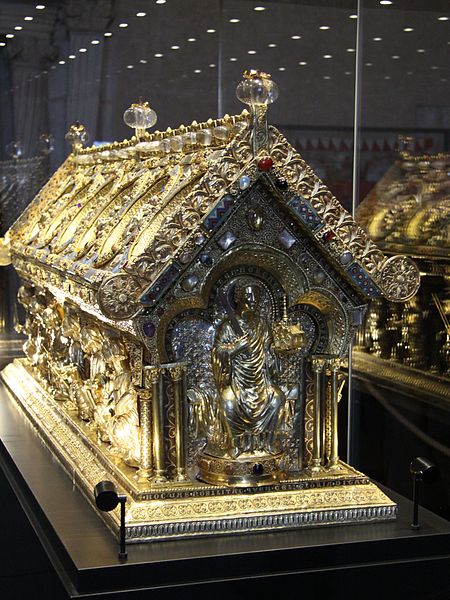St. Maurus
Deacon, son of Equitius, a nobleman of Rome, but claimed also by Fondi, Gallipoli, Lavello etc.; died 584. Feast, 15 Jan. He is represented as an abbot with crozier, or with book and censer, or holding the weights and measures of food and drink given him by his holy master. He is the patron of charcoalburners, coppersmiths etc. — in Belgium of shoemakers — and is invoked against gout, hoarseness etc. He was a disciple of St. Benedict, and his chief support at Subiaco. By St. Gregory the Great (Lib. Dialog., II) he is described as a model of religious virtues, especially of obedience. According to the Vita (“Acta SS.” II Jan., 320, and Mabillon “Acta SS. O.S.B.”, I, 274) he went to France in 543 and became the founder and superior of the abbey at Glanfeuil, later known by his name. This Vita ascribed to a companion, the monk Faustus of Monte Cassino, has been severely attacked. Delehaye (loc. cit., 106) calls it a forgery of Abbot Odo of Glanfeuil in the ninth century but Adlhoch (Stud. u. Mittheil ., 1903, 3, 1906, l85) makes a zealous defence. On the Signum S. Mauri, a blessing of the sick with invocation of St. Maurus given in the Appendix of Rituale Romanum, see “Studien u. Mittheil.” (1882), 165.
FRANCIS MERSHMAN
St. Placidus
St. Placidus, disciple of St. Benedict, the son of the patrician Tertullus, was brought as a child to St. Benedict at Sublaqueum (Subiaco) and dedicated to God as provided for in chapter 69 of St. Benedict’s Rule. Here too occurred the incident related by St. Gregory (Dialogues, II, vii) of his rescue from drowning when his fellow monk, Maurus, at St. Benedict’s order ran across the surface of the lake below the monastery and drew Placidus safely to shore. It appears certain that he accompanied St. Benedict when, about 529, he removed to Monte Cassino, which was said to have been made over to him by the father of Placidus. Of his later life nothing is known, but in an ancient psalterium at Vallombrosa his name is found in the Litany of the Saints placed among the confessors immediately after those of St. Benedict and St. Maurus; the same occurs in Codex CLV at Subiaco, attributed to the ninth century (see Baumer, “Johannes Mabillon”, p. 199, n. 2).
There seems now to be no doubt that the “Passio S. Placidi”, purporting to be written by one Gordianus, a servant of the saint, on the strength of which he is usually described as abbot and martyr, is really the work of Peter the Deacon, a monk of Monte Cassino in the twelfth century (see Delehaye, op. cit. infra). The writer seems to have begun by confusing St. Placidus with the earlier Placitus, who, with Euticius and thirty companions, was martyred in Sicily under Diocletian, their feast occurring in the earlier martyrologies on 5 October. Having thus made St. Placidus a martyr, he proceeds to account for this by attributing his martyrdom to Saracen invaders from Spain — an utter anachronism in the sixth century but quite a possible blunder if the “Acta” were composed after the Moslem invasions of Sicily. The whole question is discussed by the Bollandists (infra).
Acta SS., III Oct. (Brussels, 1770), 65-147; MABILLON, Acta SS. O.S.B., I (Paris, 1668), 45; IDEM, Annales O.S.B., I (Paris, 1703); IDEM, Iter italicum (Paris, 1687), 125; GREGORY THE GREAT, Dial., II, iii, v, vii, in P. L., LXV, 140, 144, 146; PIRRI, Sicilia sacra (Palermo, 1733), 359, 379, 432, 1128; ABBATISSA, Vita di S. Placido (Messina, 1654); AVO, Vita S. Placidi (Venice, 1583); Compendio della vita di s. Placido (Monte Cassino, 1895); DELEHAYE, Legends of the Saints, tr. CRAWFORD (London, 1907), 72, 106.
G. ROGER HUDLESTON (Catholic Encyclopedia)











